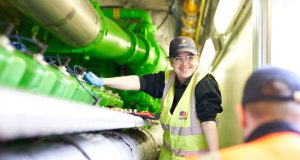2017 brought some interesting developments for commercial office occupants; over half of employers now offer some form of flexible working; smart building technology made further inroads and wellbeing looks set to become as important to FM and property management as sustainability credentials. But what do the leading FM and property experts believe will be the key trends for 2018?
 WORKPLACE DESIGN EXPERT’S VIEW
WORKPLACE DESIGN EXPERT’S VIEW
STEVE BREWER,
CO-FOUNDER BURTT-JONES & BREWER
Trends is the wrong word. That might sound deliberately obtuse, but it is important to remember that a trend is something that’s followed as a passing fashion. Trends do come and go; they have their time. Like the 1970s. Who wants brown bathroom suites at home or statement furniture at work nowadays? What workplace requires, and what FMs and property pundits need are consistencies, strong reliable quantifiable truths they can build a strategy around to ensure they deliver effective spaces. The ideas being developed now, that we might see as trends, will be tested and if they pass the test they will become the ‘givens’ embedded in FM service agreements and CRE strategies by 2019. Following a trend in the built environment can be an expensive mistake. Don’t do something because your competitors choose to; don’t buy that particular chair because someone says it is the latest thing. Test it. See if it breaks. It might not be fit for purpose.
Co-working will be the big thing tested by the large corporates in 2018. Therefore, it will be seen as a growing trend and different models will be debated in the media and tried out. The large owner occupiers and developers need to make their capital assets work harder. That means CRE teams will be seeking ways to divide, or split up their spaces and create ways to encourage teams to adopt agile working and overall a more flexible approach to working. Co-working ‘might’ benefit landlords and tenants financially, but it ‘might’ also benefit their people in terms of wellbeing, engagement and in theory productivity. Either way, as it is tested and rolled out more, FM teams need to learn how to manage these spaces and be quick to adapt to change.
There is going to be changes in employment and workplace behaviours driven by the rise of the gig economy and an ‘uber’ approach to people and roles. That will be reflected in the workplace. Co-working feels like one solution – in fact in many ways it is already a ‘thing’ and we will see more distressed, coffee shop style spaces. They do not have to be like this. What would be great in 2018 is to see ‘different’ spaces develop beyond being more than a coffee shop or gym membership based location with added laptop and WIFI.
All this thinking also gives more decision-making power to people. As co-working, gig economic thinking and uber working evolves empowerment of employees rises. It should generate freedom of movement and that freedom gives a chance for more and very different decisions around desking, chairs, lighting and the flow of coffee too.
How this choice and flexibility is managed and channelled to be creative, productive and effective is the shared responsibility of workplace designers and FMs. Together we need to educate our clients and maybe some of the fit-out firms as well, so they understand which workspace style and format is right for them.
 THE PROPERTY, WORKPLACE AND CHANGE EXPERT’S VIEW
THE PROPERTY, WORKPLACE AND CHANGE EXPERT’S VIEW
NEIL USHER,
WORKESSENCE
Chasing comets that have already appeared in the sky is relatively easy, with predictable property and workplace trends for 2018 – the increasing rise of co-working and its domesticated aesthetic, the scramble for wellbeing accreditation, the forestation of the office landscape and the increasing penetration of predictive and preventive algorithm-fuelled technology for building and fixed asset performance and maintenance. Anticipating new ones and being ready for the first shards of light is far more difficult. So, having plugged a bucketload of Big Data into a sophisticated AI engine – as in, complete guesswork – here are a few that may surprise.
First, the inaugural failure of a major provider of flexible (co-working, in old money) space due to over-extended liabilities and falling revenue from market over-supply. There will be market jitters and belt-tightening, and a number of purported deals will not materialise. Corporates will check their drive to shift their skateboarders out and issue Meyer-minor recalls of people back to HQ where the soya latte isn’t as good but everyone is comfortingly in shot of the all-seeing eye.
Secondly, due to a series of highly-publicised claims for personal injury resulting from garden-shed inspired workplaces where an expectation that work requiring a PC was to be completed at a deckchair in a sandpit, the great survivor, the desk, will enjoy an unexpected renaissance. We will see workplace design begin once again to place the desk at the heart of the scheme while being secretly happy to celebrate its versatility. Like returning home after walking barefoot across the Andes.
Thirdly, a large FM company will at last shift its commercial proposition from the fixed asset to the person. That is, instead of just talking about it. There will be the usual under 10s-football-style rush to do the same. Some will get it right, some will get it hopelessly wrong, because it’s not as easy as it sounds. Unlike talking about it.
Fourthly, there will be a major stand-off between IFMA and the BIFM over the claim to represent ‘workplace’, and an undignified re-branding battle will begin that will leave both with bruises. Realistically neither will represent workplace until they create and sustain meaningful and mutually-beneficial relationships with the design, management, construction, furniture and IT sectors. This will take one, or both, several more productive years to achieve. The trouble of course being that most years aren’t very productive.
Finally, there will be a drive to simplicity in creating and managing the workplace. Gobbledygookery will reach saturation, and burst in an unimpressively empty manner, leaving a small puddle of disappointment. We will at least realise that the workplace can be a simple and achievable proposition, and that managing it doesn’t require a seat at the table. I have a slight personal interest here, having written a book, The Elemental Workplace, out on 1 March 2018 which focusses on practical, understandable ways to create an amazing workplace, drawing on 25 multi-sector occupier-side years in the business. There are no predictions in the book – but a lot of stuff that may help us get it right today, and that has to be a useful place to start. In 2018, we can do this.




